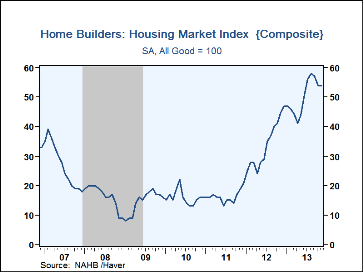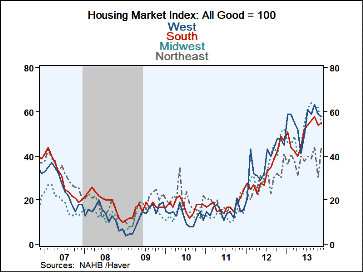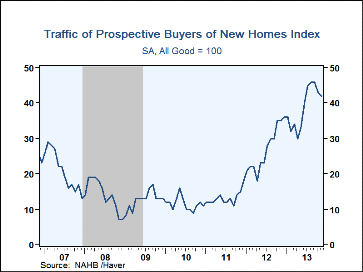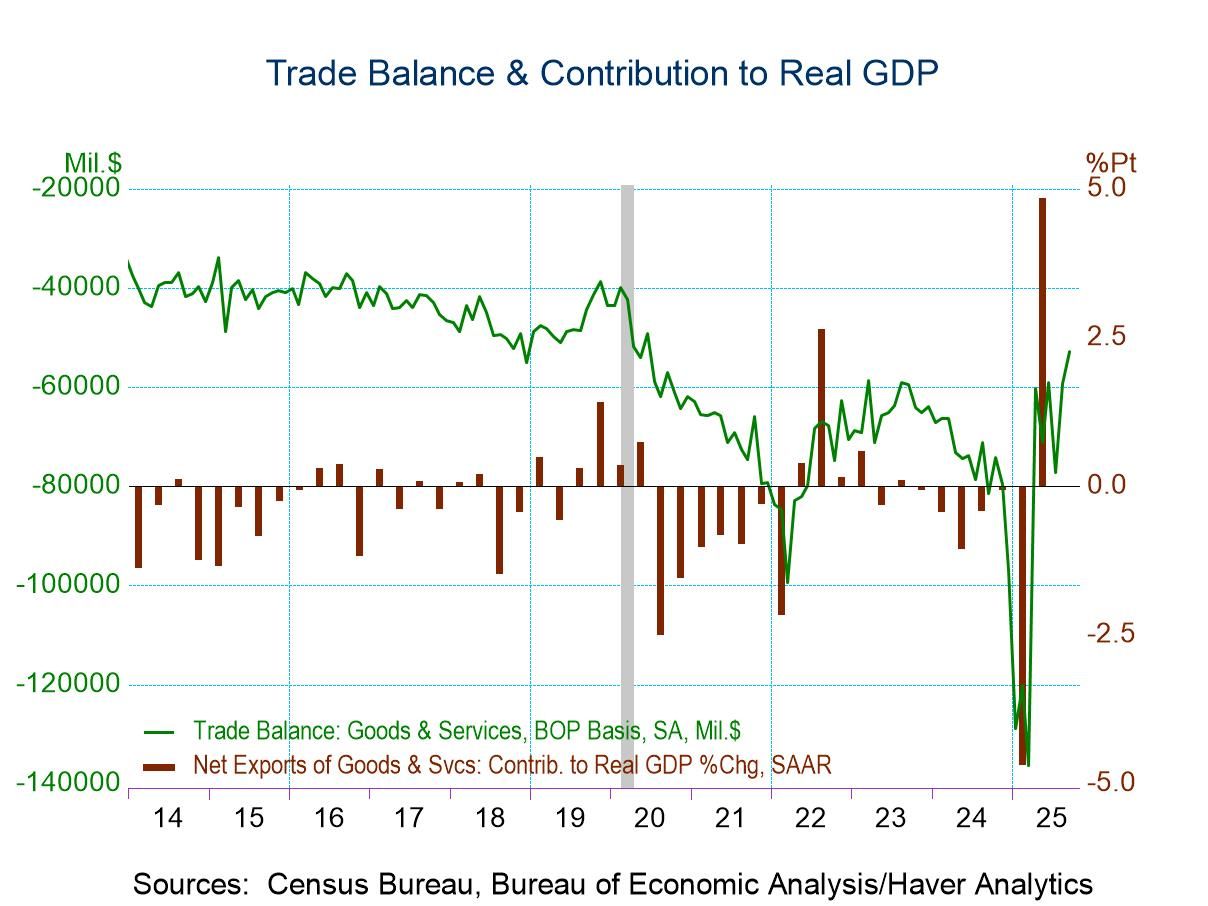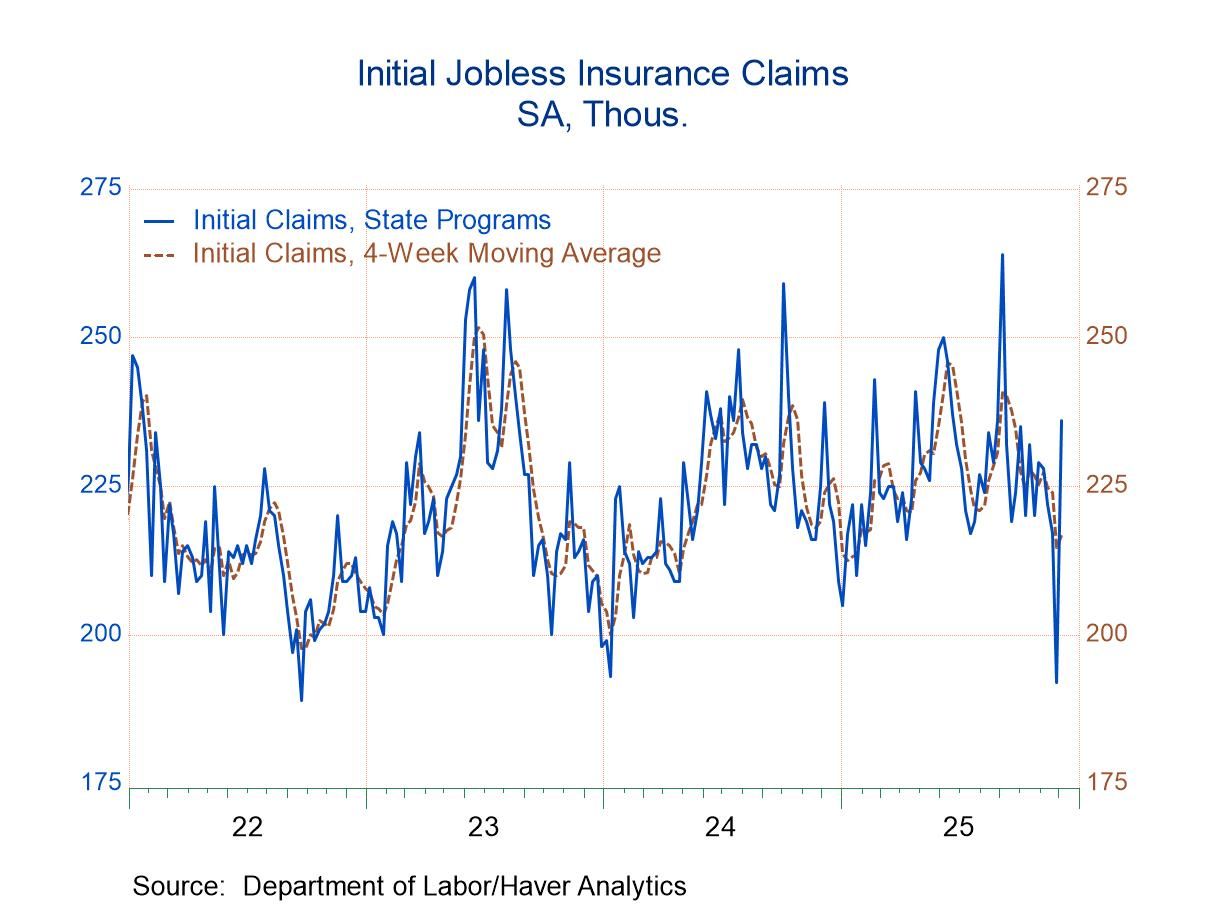 Global| Nov 18 2013
Global| Nov 18 2013U.S. Home Builders Index Is Steady Following Sharp October Decline
by:Tom Moeller
|in:Economy in Brief
Summary
The Composite Housing Market Index from the National Association of Home Builders-Wells Fargo was unchanged at 54 this month after a 3 point decline in October, last month reported as a 2 point dip. This latest figure was weaker than [...]
The Composite Housing Market Index from the National Association of Home Builders-Wells Fargo was unchanged at 54 this month after a 3 point decline in October, last month reported as a 2 point dip. This latest figure was weaker than expectations for a drop to 55, yet remained up 20% y/y. The index of single-family home sales held at 58, the lowest reading since June. The index of sales during the next six months slipped to 60. Realtors reported that their traffic index of prospective buyers weakened to its lowest level since June.
Activity was mixed around the country. The index for the Northeast increased to 44 after a sharp October decline. In the South, the index recovered just a piece of its sharp October drop. The figure for the Midwest declined 8 points following a downwardly revised October slip. Activity in the West slipped after a drop in the October index to 59. The NAHB figures are seasonally adjusted.
The NAHB has compiled the Housing Market Index since 1985. It reflects survey questions asking builders to rate market conditions as "good," "fair," "poor" or "very high" to "very low." The figure is thus a diffusion index with numerical results over 50 indicating a predominance of "good" readings. The weights assigned to the individual index components are .5920 for single family detached sales, present-time, .1358 for single family detached sales, next six months; and .2722 for traffic of prospective buyers. The results are included in Haver's SURVEYS database. The expectations figure is available in Haver's MMSAMER database.
GDPplus, from the Federal Reserve Bank of Philadelphia, is a measure of the quarter-over-quarter rate of growth of real GDP in annualized percentage points. It improves on the BEA's expenditure- and income-side measures. The Bank's write-up of the new measure is available here.| National Association of Home Builders | Nov | Oct | Sep | Nov'12 | 2012 | 2011 | 2010 |
|---|---|---|---|---|---|---|---|
| Composite Housing Market Index, SA (All Good=100) | 54 | 54 | 57 | 45 | 34 | 16 | 16 |
| Single-Family Sales: Present | 58 | 58 | 60 | 49 | 36 | 16 | 16 |
| Single-Family Sales: Next Six Months | 60 | 61 | 64 | 52 | 41 | 22 | 23 |
| Traffic of Prospective Buyers | 42 | 43 | 46 | 35 | 27 | 13 | 12 |
| Northeast | 44 | 30 | 44 | 30 | 29 | 17 | 20 |
| Midwest | 54 | 62 | 63 | 51 | 36 | 14 | 14 |
| South | 55 | 54 | 58 | 49 | 34 | 18 | 17 |
| West | 58 | 59 | 63 | 48 | 38 | 15 | 13 |
Tom Moeller
AuthorMore in Author Profile »Prior to joining Haver Analytics in 2000, Mr. Moeller worked as the Economist at Chancellor Capital Management from 1985 to 1999. There, he developed comprehensive economic forecasts and interpreted economic data for equity and fixed income portfolio managers. Also at Chancellor, Mr. Moeller worked as an equity analyst and was responsible for researching and rating companies in the economically sensitive automobile and housing industries for investment in Chancellor’s equity portfolio. Prior to joining Chancellor, Mr. Moeller was an Economist at Citibank from 1979 to 1984. He also analyzed pricing behavior in the metals industry for the Council on Wage and Price Stability in Washington, D.C. In 1999, Mr. Moeller received the award for most accurate forecast from the Forecasters' Club of New York. From 1990 to 1992 he was President of the New York Association for Business Economists. Mr. Moeller earned an M.B.A. in Finance from Fordham University, where he graduated in 1987. He holds a Bachelor of Arts in Economics from George Washington University.


